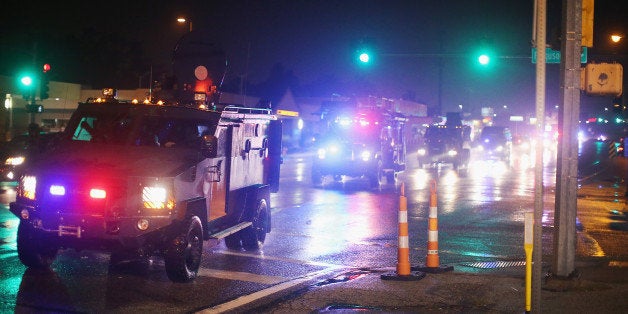
Cross-posted with TomDispatch.com
Sometime in late November, after the Paris terror attacks but before the one in San Bernardino, I was walking to New York's Grand Central Station to catch the subway home. In front of one of its main entrances, the police had set up shop, blocking off part of an avenue. The crew I stumbled upon may, in fact, have been part of the new counterterrorism unit that the New York Police Department had just rolled out. Whatever the case, the cops were up-armored in a purely military fashion (even if their togs were fashionably black and blue) and carrying weaponry the likes of which I had never seen before on the streets of my hometown. Amid flashing lights, they stood there with dogs on leashes looking not like "the police" but figures from some dystopian, futuristic sci-fi flick. Nothing in particular seemed to be happening so, after a few minutes, I entered the vast terminal, passing scattered pistol-packing soldiers in camo, evidently guarding the just-before-rush-hour crowds. It was certainly a spectacle, but also just part of the new American normal.
So consider what I'm about to mention less than newsworthy amid all the reports on the militarization of the country's police and their brutal behavior. And yet it's the sort of tiny news story that once upon a time would have been striking. Now, few will even notice. Policing headlines these days, after all, gravitate to graphic videos of cold-blooded police killings in places like Los Angeles, San Francisco, and Chicago. (There were 70 fatal shootings by the Chicago Police Department alone between 2010 and 2014. As Margaret Talbot pointed out in the New Yorker, only Phoenix, Philadelphia, and Dallas "had a higher number per capita.")
When it comes to the arming of the police in a country in which rural sheriffs proudly sport battlefield-grade mine-resistant ambush protected vehicles, or MRAPs, and new militarized urban police units like that one in New York City are being outfitted with Colt M4 semiautomatic assault rifles and machine guns, a report that 20 campus cops at Boston's Northeastern University are going to be armed with semiautomatic rifles qualifies as distinctly ho-hum news. Or thought of another way, it catches the everyday reality of a country whose police have been up-arming with a kind of passion since 9/11. I can, of course, remember the unarmed campus cops of my own college days and, believe me, we've traveled a long road from policing "panty raids" to facing on-campus mass shootings in a country now so over-weaponized that it seems as if both the police and the citizenry are in an undeclared arms race.
In these years, the militarization of the police has taken place amid a striking upsurge of protest over police brutality, abuses, and in particular the endless killing of young black men, as well as a parallel growth in both the powers of and the protections afforded to police officers. As TomDispatch regular Matthew Harwood reports today in "The Logic of the Police State," all of this could easily add up to the building blocks for a developing police-state frame of mind. If you've been watching the national news dominated by panic and hysteria over domestic terrorism, including the shutting down of a major urban school system over an outlandish hoax threat of a terror attack, or the recent Republican debate over "national security," which turned out to mean only "ISIS" and immigration, can there be any question that the way is being paved for institutionalizing a new kind of policing in this country in the name of American security and fear?
